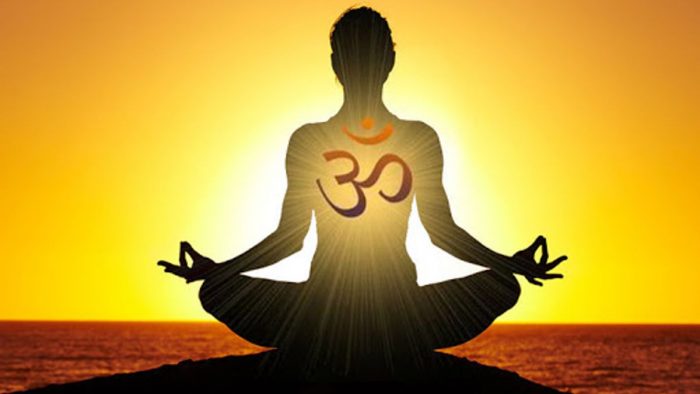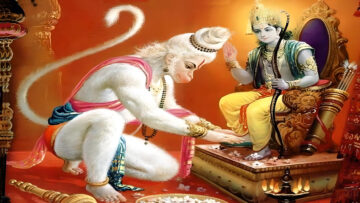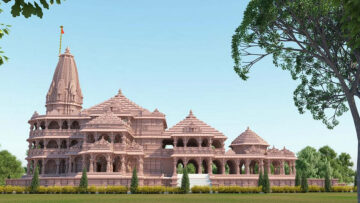Many of us grew up in households where some mantras whether suprabhatam or Bhaja Govindam played in the backgrounds or like in my case my Grandmother had deep faith in Hanuman, so she chanted the Hanuman chalisa silently or like my Mom, chanted it loudly so that the entire home was filled with those vibrations. It was only till I started learning yoga that I was exposed to the power of sound, chants and the voice as a tool to help, heal and progress.
Raghu Ananthanarayanan a yogi coach helps give more details on yoga, sound and chanting. Shankar Janardhanan has been practicing and studying Vedic Chanting for many years and joined us in the conversation.
Question: Before we come to the aspect of chanting, can you give us a little background on a yoga sAdhana?
Raghu: The focus of yoga abhyAsa is tapas. You may ask why is tapas the starting point? Most people have a mind that is conditioned, so our responses and views of the world are also conditioned that comes from a space of strong compulsive energy. These actions cause disturbances or duHkha. Only when I have a sense of my inner processes and choice making, I may be able to go beyond this duHkha. tapas is the process by which one ripens or purifies the mind and body, in order to dissolve these compulsive responses.
Question: How does the ripening happen?
Raghu: Ripening is through the heat, which is of three types- dhyAna agni (insightful mind), jAThara agni (digestive fire) and dEha agni (body heat). If the fire is subdued or over emphasized, ripening cannot take place. There are many practices in the yoga sutra to tend this fire in the right way so that the seeds of these samskAras can be burnt.
Shankar: Ripening is tapas, and tapas ripens. vAk (in its four-fold form) is agni the manifest. It rises with the prAna agni to become one with dhyAna agni in the manas. This is the reverse process to go back to the source. manas, prAna and vAk was how manifestation happened from the formless puruSha/Atman.
Question: Ok, then where does chanting come into the picture?
Raghu: Chanting has three levels, namely-:
- There are praNa nAdi-s within our body, which are energy channels. The vibration of the chants if done correctly help cleanse the channels to streamline the flow of energy. At this level you may not understand the meaning of the chants, but they have an effect on you. Thus, the choice of chant is the basis of your specific need. For e.g. years ago, I had a young student who was chanting the agni bIja mantra with vIrabhadrAsana and after a few weeks he developed red eyes, boils and experienced tremendous anger. All of this happened because the heating process became excessive.
- The second level is when you start adding meaning or try and understand the object being referred to in the chant. E.g. If I chant the gAyatri mantra, I bring my focus to the rising sun. This will enhance the experience of the chant along with the sound. The yogic theory says that the object of my attention affects my psyche. In this case the morning sun is one of the purest forms of nature and the rays can help dissolve the inner blocks. Care must be taken to choose the devata of the mantra.
- The third level is when you pay attention to the origin of the sound and energies of the prakRti that generate the sound itself. This means that your mind is becoming subtle, and acts from buddhi level (and not the more gross level of manas). In a deeper sense, you start identifying with purusha and shakti. This has been described in great detail in the shiva sutras. mAtRka refers to the vibration of the letter or prakRti as the mother. prakRti is composed of the energy of satvam, rajas and tamas. These three interact in certain ratios, proportions and rhythms and this interaction is the basis of manifestation. Chanting helps one to harmonise the mind with this fundamental pattern.
Shankar: There are shlokas that describe the beauty and power of the divine. sahsranAmam focuses on the myriad aspects of one devata or Ishvara. There are bIja mantras that awaken psychic energies and there are vEda mantras. Each have a different effect. bIja mantras and vEda mantras emanate from the pranava mantra or Om. Thus, their sound is the same as their visual or energy form and are integrated and balanced. Any regular chanting will on their own help you discover the picture that is implicitly held in the sound. If one takes the four-fold idea of the psyche- para, pashyanti, madhyama and vaikhari, the vEda and bIja mantra takes you from the vaikhari, the manifest, via the madhyama which is breath/prAna, to pashyanti the seen and then to parA the formless.
With vEda mantras and bIja mantras, chanting alone leads you to all other inner experiences. This framework helps when you start chanting.
Question: So, is it important to first just listen to the chants?
Raghu: The process of learning of the shastras always follows the three steps, shravaNam, mananam and nidhidhyAsitavyam. Usually a teacher will chant a line and student will repeat it twice with proper pronunciation, pauses, and intonation. You cannot be repeating the wrong sounds. This awakens the power of listening to the sound from the teachers’ chanting and from one’s own repetition i.e., shravaNam. The meaning is then slowly revealed to you so that you can internalize the deeper aspects.
Question: Some mantras are said to be chanted in the mind and some aloud. Why?
Shankar: In my understanding, you start learning a chant by repeating it orally and then as you keep repeating it, it is absorbed at a deeper level like a resonance. That way it is easy for the mind to disengage from the external and focus on the chant. They say chanting a stotram is beneficial so that there is no space for other kinds of samskAras to creep in. The mind becomes refined, subtler and can connect with the bhAvana quicker.
Question: Are there any restrictions to who can chant?
Raghu: There are some, certain chants women or pregnant women should not recite or listen to. Like rudram, during the menses should be avoided because it causes a lot of body heat. Not everyone can eat all medicines, right? You ought to eat medicines or chant what is appropriate for you and your condition. But, according to Yogacharya Krishnamacharya women should learn chanting. Chants have a direct effect on the system. Note that Chanting is a very structured exhale. Exhalations have a physical effect. It is proper to be cautious with what one chants
Question: So, the impacts and experiences will also vary with each person?
Raghu: True. Each person must listen carefully when chanting and be sensitive to how they are responding to the vibrations. This will help them figure out what that chant means to him or her. Then one can approach a teacher to delve further. The sutra yathA abhimata dhyAnAt vA emphasizes that one ought to understand one’s own responses to the practice in a sensitive way and take charge. abhimatam means something that goes well with you and creates a well-being in you. dhyAna is the meditative process. Thus, it is important to be sensitive to your body, breath and mind to make the right choices about chants.
Question: What are the food restrictions or do’s and don’ts when chanting?
Raghu: All the basic recommendation on food apply to the chanting process also. Since the chanting arouses inner energies, food that is rajasic is to be avoided. Tamasic food is likewise not advisable because they will dampen the effect of the chanting. They say you should have lots of ghee and milk to cool the system because chanting produces a lot of heat. Proper Asana and prANAyAma before chanting will increase the efficacy of the chanting.
Question: Does the musical notes or octaves matter here?
Shankar: Each letter of the chant is assigned one of the three levels- udAtam (the high note), anudAtam (the low note) and svaritam (the normal note) unlike the 7 swaras of music. Of course, a higher octave produces more heat and lower ones have a cooling effect. So, the choice must be made wisely.
Question: What physiological effects does chanting have?
Shankar: There are many positive outcomes that the shAstra-s indicate. There is tremendous clarity in communication and especially when does the chanting with complete dedication to the divine energies, it facilitates one’s search for truth. The uchArana of Sanskrit has great effects on the entire vocal system, unlike any other language. There are letters that use the whole sound producing apparatus of the body and especially the various parts around the vocal cords. The other impact is at the throat center where all the 5 vAyus– samAna, udAna, apAna, vyAna and prAna vAyu converge. So, if you sit upright and chant properly the entire prAna vAyu system gets cleansed. The more cleansing happens the chances of expressing the truth and other yama become better.
Question: Can chanting help you become reflective?
Raghu: If you are working at the first level where you are not adding the mental practice then it may not, and you would have to follow it with some other practices. But if you are at the second and third level, you are reaching a subtler mind that becomes capable of dhyAna.
Question: How can I engage all my indriyas while chanting?
Shankar: To engage all senses very actively and easily is quite a challenge because you are sensitizing yourself and locating the self at a very subtle level. As we go deeper there is an artha bhAvanam and clarity in the meaning of the chant. When we chant ‘Om’, you may experience it as Ishvara in a direct manner. Chanting ‘Om’ itself is powerful.
Question: What does it indicate?
Shankar: ‘Om’ implies the whole of creation, beginning of time and end of time or beginning and end of creation.
Question: Sometimes, my teacher just asks me to chant Om namaha without an object in mind and just focus on the sound for concentration. Then over a period of time as we practice this, the gap between 2 chants of Om namaha increases. The idea is to experience the gap. Is it true?
Raghu: True. The closer one gets to the origin of the sound, the more you get into silence.
Question: I also have got in touch with many memories after chanting and even the body opens up for me to listen.
Raghu: Exactly, that is what chanting is meant for. When I say clearing up the nAdi (subtle energy channels) then it means that during a conditional response, not only the mind but the body also retains several memories. The yoga sutra calls cleansing as prakRti ApUraNam i.e. my prakRti has to undergo a change and not just my mind. When my mind is distorted my prAna nAdis are also distorted or in other words I will experience lack of well-being.
Question: What do kavacham chants do?
Shankar: It is recommended that we practice a process of creating a kavacham or a boundary to protect us. Especially when we need protection from the outside.
Question: Can women chant?
Raghu: There is no such thing that women cannot chant. In my years of study with Krishnamacharya, this has been a topic raised several times by many people including traditionalists. He would teach chanting to women as well as to traditional people. His answer was simple “In yoga rahaysyam, it is recommended that women must learn chanting. Secondly, there are number of women rishi-s who contributed to the vedA-s. Thirdly, when the father taught the child how to chant and the child practices, the mother must also know the chants in order to correct it”. In fact, Krishnamacharya has said that his mother used to correct him when he made a mistake. Another argument he used was-: he asked if we accepted the word ‘Om’ as Ishwara. We also believe that Ishvara and Atma exist in every being, then who can say that women should not chant, and men can? Or any human being for that matter when the divine already rests within the person?
Shankar: I totally concur. Vedas have very many RshikAs to whom mantras were revealed. eg. vAk suktam of eight verses was revealed to a female Rshi (or RshikA) called vAk, the daughter of Rshi Ambhrina
Question: Do people from other faiths who come to learn yoga have any problems when we use chants as one of the tools?
Raghu: When a person comes to learn yoga, they are pretty open to chanting as well. I remember teaching people from multiple faiths. There was one Muslim man who had a terrible back pain and along with some light movements I also made him chant, which he did without any hesitation. He understood that Om and Allah refer to the unnamable and infinite, so it was not a problem. In fact, I have had more problems from Hindus who are very stringent about the way it is chanted and go on to quote some scriptures. Of course, there are people from all walks of life caught with all kinds of orthodoxies, but that is the exception and not the rule.
Remember the sutra yathA abhimata dhyAnAdvA, where no one is forcing anyone to chant a certain mantra. You are to pay attention to yourself and find out what is meaningful to you and touch the Ishvara within you. The more you touch the subtle levels of your mind the understanding becomes clearer.
Krishnamacharya often said that if somebody wants to choose to box that Divine Energy of Life within some intellectual concept, then they are doing something that is fundamentally wrong.
Question: The question is not foreigners or other faiths, but is the person hanging on to a dogma through fear or not?
Raghu: A dogma that says that there is only one way has no place in yoga sAdhana.
Question: My mother has a bhajan or chanting group, and whenever they meet at home the energy changes. Even if I do not join in, it affects me.
Shankar: Of course, it will. This is called a satsang i.e. sat is good and sangha is community; a group which has a dharmic intent. When the group chants, you are also listening and responding or sa hridayatvam is created. It means there is a resonance of hearts, which has a positive effect on the environment. But there are some chants to be done on your own only. If a teacher gives you an upadesam, then one does not chant it in public. ‘Om’ is chanted aloud to resonate with everyone and the space.
Question: They say one should stick with one mantra, usually to your ishta devata and stay with it. What is your view on that?
Shankar: Some of chanting is the svAdhyAya part of yoga, to understand sadvicharam (proper enquiry) and sadvitarkam (rational and logical thinking). Not all vedAs are praises to deities or evoking inner states of being. They talk about a variety of topics, philosophical discourses. Thus, there are different chants applicable. When I chant on my ishta devata it is to make the inner core of my prAnic energy strong to resonate with my prakRti. When a teacher or Guru gives you a chant, s/he has sensed this is suitable and your prAna becomes aligned thereafter.
You also need to practice this daily, at one place and time. The place enhances the energy receptivity of the chant.
Question: I started learning chanting a few years back and I was not sure if I should chant during my periods. Most cycles I feel like just being quiet and not being too loud.
Raghu: The general recommendation is not to chant during periods because it increases the heat in the body. Periods are a kind of natural shuddhikarna of the whole system, unlike men who do not have this and must do some other practices for shuddhikarna. This is a basic understanding of the nature or prakRti of a person; women are closer to nature and flow of nature rather than men. Now in this natural process, you do not want to burden the system with loud sounds, wrong food and emotional excitement because the nADis are sensitive thanks to the cleansing.
Even for a few days after the period, one should be careful and allow the system to re-calibrate and settle.
Question: I feel like sitting quietly and practicing breathing light humming or Om chanting.
Raghu: True, that is fine. Each one has to find what works for them.
Disclaimer: The opinions expressed in this article belong to the author. Indic Today is neither responsible nor liable for the accuracy, completeness, suitability, or validity of any information in the article.










